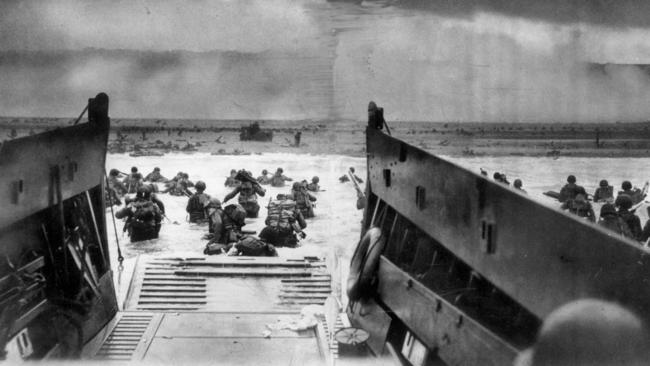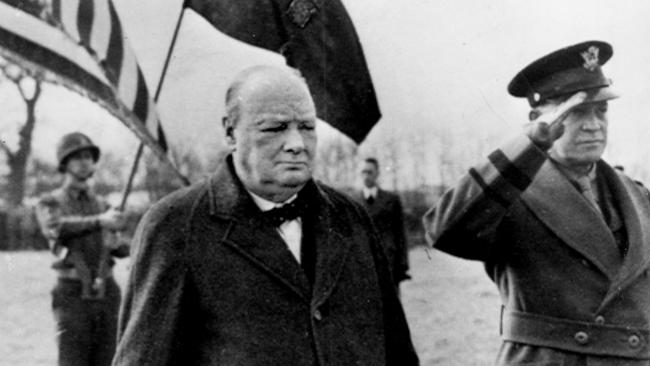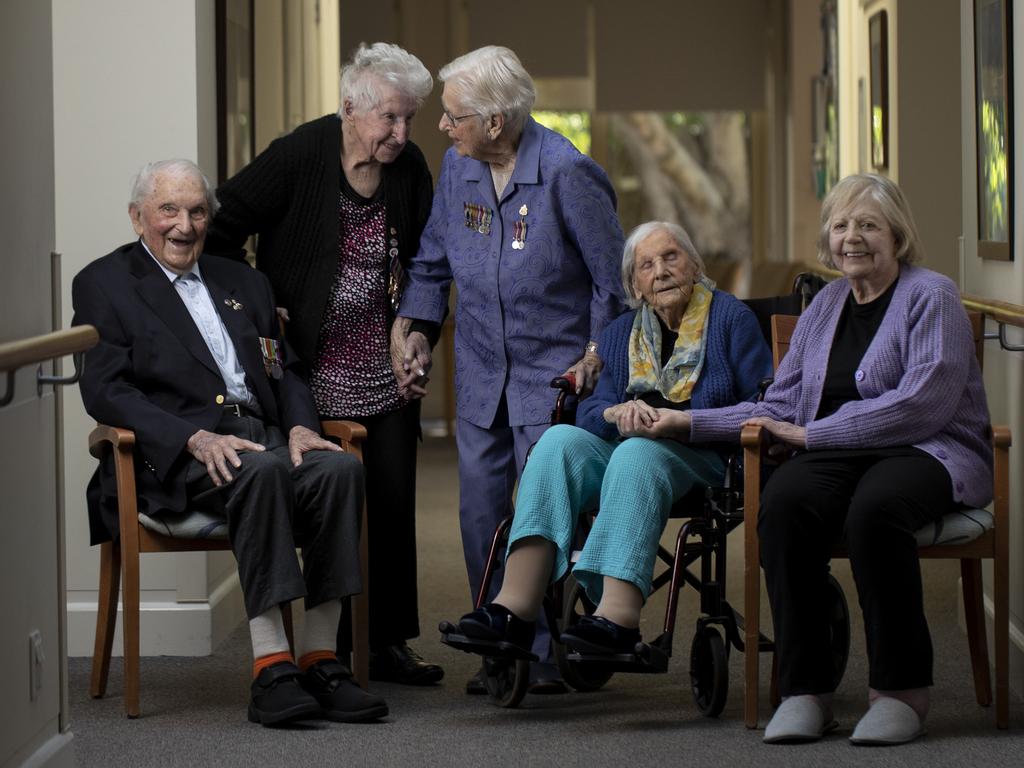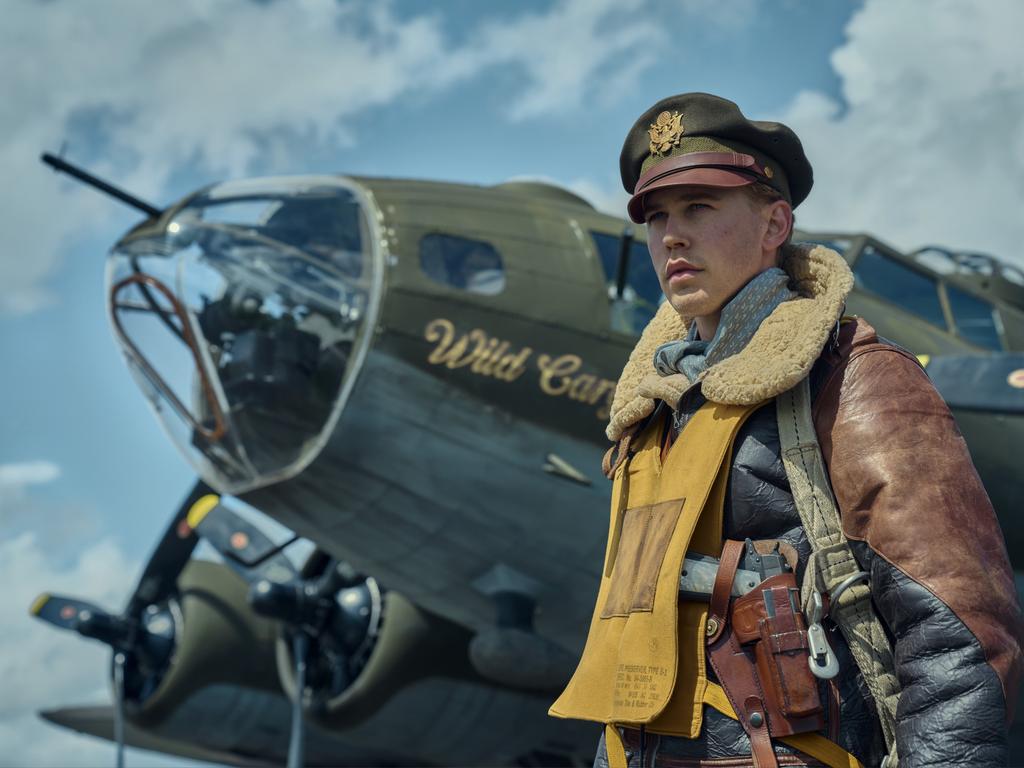Hobart teacher’s secret mission to guide the D-Day fleet
Eighty years ago Tasmanian mariner Kenneth Hudspeth was cramped in a midget submarine lying on the bottom of the sea floor off Juno Beach on the Normandy coast for Operation Gambit.

For three nights he cautiously surfaced and anchored in the dark to listen to the 11pm BBC broadcast that was to impart a coded message as to when D-Day – the top-secret Allied invasion he had been privy to for weeks – would begin.
Hudspeth, a Hobart schoolteacher, was just 26 and a world away from his Tasmanian roots. He was already a decorated commander in the Royal Navy, in charge of a crew of four people, and had earned a Distinguished Service Cross for a mission involving the German battleship Tirpitz.
His boat, the X20, codenamed Exemplar, was a midget submarine just over 15m long, powered by a bus diesel engine, and at this moment was quietly and secretly positioned ready to guide the D-Day fleet to the correct invasion spot.

Unlike the D-Day aircraft that were painted in white stripes for easy identification among the Allied forces, the Exemplar was camouflaged for the shallow French waters, coloured yellow ochre, stone and green to hide from the myriad German coastal guns and blend in with the seabed floor.
Another midget sub, the X23, was sitting off nearby Juno Beach. Both boats were poised to pop up at dawn at the moment of the Normandy attack by Bomber Command aircraft and the beginning of naval fire from offshore.
But this story begins much earlier. Hudspeth, skilled not only in all operations of the submarine, including navigation (the boat had only a Chernikeeff log to assist in direction), electrics and even deep sea diving, had been in this area off the coast before.
Those Allied forces landing on the D-Day beaches in 1944 may have believed they were the first to tread on the French sand in the past few years, but the reality was that stretches of the coastline had been carefully core sampled and analysed by a remarkable unit called the Combined Operations Pilotage Parties that same year.
Four months before D-Day, in a clandestine operation beginning on January 17, Hudspeth had piloted the X20 with two special guests, navy COPP commandos, to the area off Omaha Beach where they stealthily carried out extensive intelligence scouting across Vierville-sur-Mer, Moulins St Laurent and Colleville-sur-Mer.
Also on board Exemplar was one of his usual crew, Bruce Enzer, and the architect of the COPP program, Lieutenant Commander Nigel Willmott. The mission reads like the script of a Hollywood movie.

Willmott later would commend Hudspeth for his handling of the top-secret operation, saying his grasp of submarine technicalities, coolness and dexterity in handling the craft submerged was of the highest order.
As for that mission, Hudspeth later would tell the Naval Historical Association of Australia: “For three afternoons, on the rising tide, we moved inshore at periscope depth till we touched sand, recording the bottom profile by echo-sounder and recording periscope observation of beaches, sea-walls, buildings, fortifications, access and other details.
“These examinations covered the area which became Omaha Beach, to be attacked by US forces. On two afternoons we were startled by sudden eruptions of that underwater pinging sound made by bullets or small shells, going on for some minutes. We hastily withdrew the periscope, went astern and scuttled for deeper water, waiting for the arrival of E-boats – but nothing happened. We never found what it was about.”
Hudspeth continued: “For two nights, after withdrawing offshore we surfaced and anchored and our two soldiers, in rubber swimming suits and equipped with a mass of measuring, recording, signalling equipment and arms, swam to shore and crawled about the beaches, dodging sentries, before swimming out again, signalling to be picked up. They were the heroes of the operation.
“While at anchor we charged batteries and at daylight each morning sank to the bottom to rest before the afternoon recce. After the third day we headed on the surface, in fresh conditions, for the Isle of Wight.”
Crucially the Exemplar’s periscope had been able to observe what was underneath camouflage netting, whether it was anti-tank weaponry or a machinegun and where the artillery was pointing.
The hero commandos were Major Logan Scott-Bowden, who would end the war with the Military Cross and a Distinguished Service Order, and Sergeant Bruce Ogden-Smith, the son of a fishing tackle manufacturer, who was awarded a Distinguished Conduct Medal and another for gallantry.
Years later Scott-Bowden spoke to the local radio station on Hayling Island, England, about the time he was aboard the midget sub and described how Hudspeth had taken it right below a French fishing fleet – with their nets out – and under the noses of the German officer smoking a Bavarian pipe at the helm of one of the boats.
He said: “We went on overnight, arrived after dawn to find a French fishing fleet with nets out. Hudspeth, the Australian commander, decided we could get through underneath nets, but a German soldier was by the bow smoking a Bavarian pipe and we didn’t want to be seen by him, but we avoided that alright.”
Off Omaha, the two commandos, dressed in waterproof suits, would launch from the sub in the dark, swim several hundred metres to shore and, using Ogden-Smith’s fishing line to measure the dune contours and a small bore sampler, would take sand and soil samples and analyse the beach conditions and obstacles. All the while they had to evade German sentries.
“If there was peat it meant there was clay,’’ Scott-Bowden said, “and that would pose a problem for tanks landing.” To ward off Germans, the two carried a .45 Colt and a dagger. When one sentry came close enough to trip on the fishing wire on the second evening, it didn’t thwart the mission but rather helped the D-Day planners understand the beach wasn’t mined.
After hours of work and evading being spotted, the duo would then swim back out more than 400m to sea, carrying all of their samples and notes in condoms, and their weaponry, battling tides, waves and the cold, flash their torches in the direction of where they hoped the submarine was positioned and wait for Hudspeth to pick them up. Every night an observant Hudspeth was successful.
Hudspeth said it was an “uncomfortable secret to carry” having been told the projected D-Day some time in advance and that throughout the early summer his crew – Enzer and Leslie Tilley – was permanently on standby.
Finally the D-Day operation was near. On the evening of May 2 Hudspeth and the X20 left England, spending a full day submerged before surfacing for a night dash across the minefield to reach the French coast in the morning.
Hudspeth recalled: “Till dark we lay on the bottom, resting, eating and countering condensation. At dark we surfaced and anchored, to listen for a radio message coded into the 11pm BBC news. It came – the invasion was postponed: we were astonished, for conditions were very moderate.” Hudspeth’s message to wait, unrecognisable to the Germans, was “For the Padfoot. Unwell in Scarborough”.
Supreme Commander General Dwight Eisenhower had calculated the ideal clear weather, full moon and low morning tides to land more than 130,000 troops fell between June 5 and 7 but the planned June 5 date was delayed because of worsening weather conditions.
Having understood this from the coded radio broadcast, Hudspeth recharged the batteries, ventilated the boat and at daylight sank for another 18 hours waiting through to the night of June 5. Oxygen supplies and having five men crowded in a boat built for four were always a concern for Hudspeth. If the invasion were delayed any further it would have created big problems.
“This time the BBC message told us it was on – in spite of rising wind and sea,” he said.
Yet not all went to plan. Exemplar was to have originally unloaded a commando with other signalling gear in a dinghy a mile west of their position, but the sea was too rough. Instead the crew checked their position lining up with various points on the shore and waited for when the D-Day air and sea attack began.
Said Hudspeth: “We started our signalling with a shaded light, a tiny radar beacon and a crude mechanical hammer to be picked up by Asdic (a sonar detecting device). And we carried the biggest ensign we could muster to reassure our own forces!”
The emotions onboard can only be imagined. Sitting off the beach as sitting ducks for any observant German defences, the crew waited patiently for the fleet of ships and landing barges to spot their signalling and manoeuvre to land at the correct place. “At last through the murk the first craft appeared and the lines of landing craft surging in the rising sea passed close on either side heading for the beaches, followed by seemingly endless streams of others, with the salvoes from the rocket ships pouring overhead,” Hudspeth wrote.
What he didn’t record, but others did, was that the crew had stood on top of their midget sub as the first landing craft came towards them and in the tremendous excitement of cheering them on to the beach Hudspeth fell into the rough waves but was quickly given a hand back up to the boat.
It was the beginning of 7000 vessels to arrive at the five beaches: the US forces at Utah and Omaha and the British and allies at Gold, Juno and Sword.
Historians say that in the next three weeks the Allied navies landed more than 850,000 men, 148,000 vehicles and 570,000 tons of stores on the beaches.
Within three months, by the end of the Battle of Normandy more than two million men, 400,000 vehicles and three million tons of supplies had been landed on the beaches.
For Hudspeth and his men, their role in D-Day had finished on the first day to great applause from their colleagues back at Gosport, Portsmouth. One of the commandos said: “One of the things I found most pleasing about Ken Hudspeth was a down-to-earth practicality of outlook.”
Despite its crucial D-Day role, the Exemplar was then sent to Scotland to help research about crush injuries and underwater explosions.
Hudspeth, who joined the Royal Australian Naval Volunteer Reserve at the beginning of the war, would continue active naval operations until the end of the war as first lieutenant of the destroyer HMS Orwell.
After the war he resumed teaching in Tasmania and, according to his son Andrew, very rarely spoke about his war experiences. He died in December 2000, aged 82. “He would be mortified to know an article was being written about him,’’ Andrew Hudspeth says.
Australian War Memorial senior historian Lachlan Grant says an estimated 500 Royal Australian Navy personnel were serving in the British fleet on D-Day. Of the 500, more than 400 were officers of the RANVR. Grant says Australians commanded two of the convoy escorts, the destroyer HMS Vanquisher, commanded by Lieutenant Commander Frederick Osborne, and the frigate HMS Loch Killin, under the command of Lieutenant Commander Stanley Darling.
He says Australians were spread across hundreds of ships, and the experiences of these sailers were diverse. “A small number of Australian naval officers were in command of destroyers, corvettes, minesweepers, landing craft and torpedo boats,” he says.
“Others served in ships crews, including commanding individual gun turrets aboard heavy cruisers.”






Eighty years ago Tasmanian mariner Kenneth Hudspeth was cramped in a midget submarine lying on the bottom of the sea floor off Juno Beach on the Normandy coast for Operation Gambit.